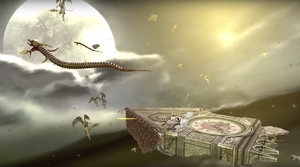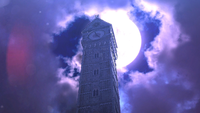Umbra Clock Tower
| Umbra Clock Tower | |
|---|---|
 Umbra Clock Tower in Super Smash Bros. for Wii U. 
| |
| Universe | Bayonetta |
| Appears in | SSB4 |
| Availability | Downloadable |
| Crate type | Normal |
| Maximum players | 8 |
| Tracks available | 3DS: Let's Hit The Climax! Theme Of Bayonetta - Mysterious Destiny (Instrumental) (Alternate) Wii U: Let's Hit The Climax! Theme Of Bayonetta - Mysterious Destiny (Instrumental) Tomorrow Is Mine (Bayonetta 2 Theme) (Instrumental) One Of A Kind Riders Of The Light Red & Black After Burner (∞ Climax Mix) Friendship Let's Dance, Boys! The Legend Of Aesir Time For The Climax! |
- Affinity redirects here. For the Smasher, see Smasher:Affinity.
Umbra Clock Tower (アンブラの時計塔, Umbra Clock Tower) is a downloadable content stage in Super Smash Bros. 4 from the Bayonetta series, released on February 3rd, 2016.
Stage layout
The battle takes place on a main platform in free fall. Occasionally falling debris comes close to the main platform, serving as extra platforms; both hard and soft platforms can appear.
Players enter and exit the alternate world of Purgatorio throughout the match. The angels Affinity, Inspired, and Fortitudo appear in the background of Purgatorio, though they do not interact with the fighters or the stage at all. In the 3DS version, due to hardware limitations, Inspired and Fortitudo do not fly near the stage and appear deeper in the background.
In both the Wii U and 3DS versions of Super Smash Bros, the "Umbra Clock Tower" stage only feature the main panel from the clock; while in Bayonetta, the entire thick head of the clock is present. Also, the Nintendo 3DS version of this stage, due to hardware limitations, uses sprites for the angels in the background, rather than 3D models like the wii u version.
Ω Form
The Ω form is aesthetically identical to the normal form of the stage, but the extra debris platforms will no longer appear, and, as a result, the camera will no longer zoom and shift. The angels can still be seen flying in the background.
- SSB4-3DS - Umbra Clock Tower Omega.png
Ω form (3DS Version)
Origin
The Umbra Clock Tower is a reference to the opening of Bayonetta, where Bayonetta and Jeanne fight angels on top of a falling clock tower face during the Witch Hunts. The stage also appears in Bayonetta 2 when Bayonetta is sent back in time. Forced to re-experience the Witch Hunts all over again, while fighting by the side of her mother Rosa, Bayonetta and Rosa witness the clock tower's destruction first-hand, due to two giant fireball attacks by the angel Fortitudo. The resulting explosion causes Bayonetta and Rosa to fall off a cliff together—a different side to the one Bayonetta's past self and Jeanne fell off.
As it begins crumbling, Rosa calls the tower the "Symbol of the Umbran Way" and begins mourning its destruction, showing that the tower itself had significant meaning to the Umbran culture, and their way of life.
In the Bayonetta series, there are three different dimensions called the Trinity of Reality: the Human World, Paradiso, and Inferno. Purgatorio, an alternate reality to the Human World which Angels and Demons can use to influence the Human World without having to directly enter it, exists between them.
Demonstration
<youtube>X81ql1cgpVw</youtube>
Gallery
- Inspired - Bayo1.png
Inspired, as it appears in Bayonetta.
Bayonetta on Umbra Clock Tower in Super Smash Bros. for Nintendo 3DS.
Trivia
- The face of the clock matches the respective system's internal clock (Wii U or Nintendo 3DS). One can even observe the clock hands moving. If the game is paused, the clock stops counting. When the game is un-paused, the clock instead skips ahead and resumes counting from the time at which the game was un-paused.
External links
- Umbra Clock Tower on Bayonetta Wiki
|
| |
|---|---|
| Fighter | Bayonetta (SSB4 · SSBU) |
| Assist Trophy | Rodin |
| Stage | Umbra Clock Tower |
| Other | Madama Butterfly |
| Trophies and Spirits | Trophies · Spirits |
| Music | SSB4 · Ultimate |






